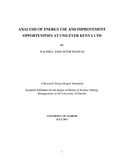| dc.description.abstract | Fast-moving consumer goods (FMCG) – or consumer packaged goods (CPG) – are products that are sold quickly and at relatively low cost. Examples include non-durable goods such margarine, culinary products, soaps and detergents. As such they have to be manufactured quickly and taken to the consumers within a set timeframe, due to their short shelf life. The absolute profit made on FMCG products is relatively small, but they generally sell in large quantities, so the cumulative profit on such products is be substantial.
Since the profit is low, all the costs associated with the production of the product have to be minimal. Such costs include; labor, energy, repair and maintenance, waste disposal amongst others. Energy cost is a critical factor since the cost is externally determined but the consumption is internally determined. As such Unilever‟s Nairobi site has experienced an increase in the energy bill over the last 5 years. This has continuously eroded the profit margins on the products. The plant is divided into several subsections which produce different categories of product. These include dry non-Soapery detergents, toilet soaps, personal care products; Vaseline, lady gay, margarine and savoury products.
Unilever Kenya has a maximum demand of 1.8MVA in 2010. The plant operates 24 hours, 6 days a week. The site has centralized utilities systems that serve all the subsections. These include two, 11t/hr, Heavy Furnace oil fired boilers, two 132kW electrical powered compressors for compressed air system, four 1000kVA generators, and centralized water supply system. Consumption in 2010 was 8,844MWh and
consumption per ton of 107kWh/t. This is up from 2007 consumption of 6986MWh, and a unit consumption of 110kWh/t. The site uses about 3.7million litres of HFO to generate energy, both for the powders tower and for the steam generation. Furnace oil contributes 60% of the energy with electricity contributing 36%. Liquefied petroleum gas provides 4%. Motors then use 54% of electrical energy in Savoury factory and 96% of energy in Margarine factory. Product sleeving in Savoury consumes 80% of steam in that factory and water heating in margarine factory consume 80% of the steam. The site has scaled down the operations in the SCC products from 90,000tonnes in a year to 25,000 tonnes. However the utility infrastructure remains the same. The boiler rating, ammonia refrigeration piping sizes still remain that of 90,000 tonnes.
Uses of high consuming energy lights in Savoury stores that consume 400W are installed. One switch controlling an entire floor is also prevalent and is found in Savoury packing floor, stores and powder feeding rooms. Maturation area for Royco beef cube blend is sized with a ceiling which 5 meters high. Standby generators are split in a way they only serve specific factories. They are designed in a way that all of them will come on incase of a power failure.
Areas found to have opportunities to save energy include removing of the high energy saving halogen lamps and replacing them with fluorescent lamps or LED lamps. Synchronising the generators so that they only run as per the load requirement, and with a maximum demand of 1800kVA, this means only two generators are required. All EFF3 motors should be phased out with EFF1 motors. This is on need to buy basis since the difference in running costs cannot justify replacing when the EFF3 motor is still in a working mode. | en |

